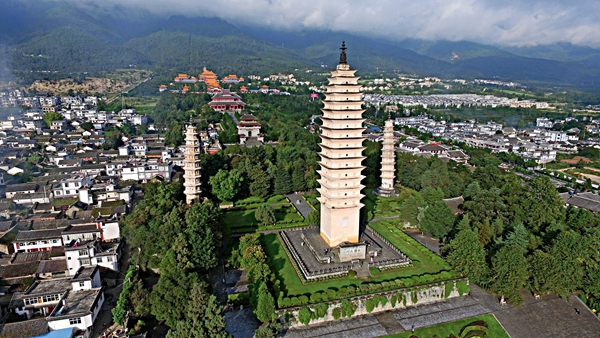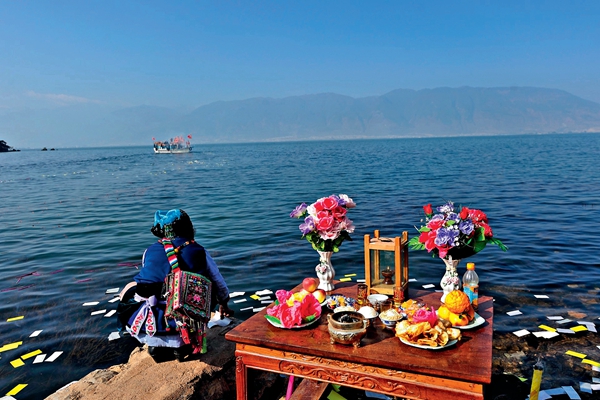Dali is where the Bai people’s ethnic roots are. From the 23rd to 25th day of the fourth lunar month every year, Bai people in Dali pray for rain and worship local patron gods (known as Benzhu in Chinese) in celebration of the grand traditional folk festival known as Raosanling. The event takes place mainly in Bai villages around Cangshan Mountain and the banks of Erhai Lake. A folk custom that harks back more than 1,000 years, Raosanling was among the first such items to be added to the National Intangible Cultural Heritage list in 2006.
“Rao” means to saunter, as people do at this festival while intermittently breaking into song and dance. “Sanling” refers to the three symbolic gods. These encompass several local deities and ancestors that are part and parcel of the native Bai religion of Benzhuism, as well as Buddhist gods introduced to Dali. The three main places to worship them are Chongsheng Temple in Dali, the Benzhu Temple of Shengyuan Temple in Qingdong Village of Xizhou Town, and the Erhe Memorial Temple in Heyicheng Village of Xizhou Town. During the festival, thousands of Bai people from various villages set out on their pilgrimage from Dali City to Heyicheng Village to worship at these three temples.

On the morning of the 22nd day of the fourth lunar month, the Bai people walk out in groups from all quarters, carrying sacrificial vessels, a few belongings, food, and cooking utensils. Their destination is the Chenghuang Temple (which worships the local city god) in the ancient city of Dali. Having lit joss sticks and candles, they are equipped for their long journey.
There is an old saying in Dali: “The first day to the north, the second day to the south, and the third day to come home.” It refers to the route of the Raosanling pilgrimage. On the first day, various groups depart from the city of Dali and gather at Chongsheng Temple’s three pagodas, where they burn incense and make their devotions. After walking north for about 16 kilometers, singing and dancing as they go, they reach Shengyuan Temple on Cangshan Mountain. There they pray to the local god for good health and favorable weather so that the land will yield a bountiful harvest. After this ceremony, some people sing folk songs as others dance on the riverbank and in the nearby woods. They also burn incense and read scriptures for praying in the temple. At dusk, they set up pots near the temple and cook dinner, and later sleep either inside the temple or in the woods.

During these three days, local people walk more than 40 kilometers, singing and dancing along the way. This is a magnificent and spectacular sight.
The customs and rituals practiced during Raosanling are folk conventions. During each festival, thousands of Bai people from various villages around Erhai Lake gather before starting out on their pilgrimage to the three temples. Their foreheads adorned with sun-shaped patterns, their heads with colorful headbands to pray for a golden harvest, they also carry gourds as a symbol of fertility.
Each group generally consists of three sections. At the front are two village elders wearing distinctive outfits of white turbans and white shirt, colorful silk pants, and slippers decorated with red-pompons. Between them they carry a gourd hanging from a willow branch decorated with lengths of colored silk. One of them also holds a horsetail whisk, the other a red fan or a white towel. In the middle of the group is a man playing the flute, accompanied by octagonal drummers, who perform a part-talking part-singing narrative on life and happiness set to traditional melodies. This is a way of showing respect for local gods, Buddha, and Taoist deities. At the end of the procession is one person who makes music by blowing a leaf, along with a dozen singing and dancing women, all holding fans or straw hats. Led by the two elders, the group converges with those from other villages in this vibrant spring festival celebrated by more than 10,000 people.
As in most ethnic festivals, young men and women’s thoughts turn to love and romance at the Raosanling. It is after all the perfect time to find a person to hold close to your heart. But the Raosanling is distinct in being an occasion when the Bai people, regardless of age or sex, dally freely with old flames and sweethearts without fear of censure from the local folk. This is a custom unique to the Bai people. lt gives former lovers the opportunity to reacquaint with one another without incurring anger or moral condemnation from their respective families. Some of the elders taking part in the festival may be heard singing the song: “Although I’m too old to sing well, I still want to sit silently by you.”
This Raosanling style Valentine’s Day gives the festival a touch of nostalgic passion.
Bai traditional society is one of multiple religious beliefs. People practice Buddhism, Taoism, and also worship local deities. The latter constitutes the specific religious beliefs of the Bai people as a whole.
Local deities are regarded by local residents as patron gods of their homes and villages. They are entrusted with bringing officials good careers, farmers good harvests, craftsmen excellent works, and merchants successful businesses.
Patron gods can be both human and immortal. Usually each village has its own, but sometimes one deity is jointly worshiped by several. Animals or other things that have close associations with the villages can become their deities, such as holy mountains, animal spirits, Buddhist and Taoist gods, Confucian models, or characters from folk tales. They can be members of royal families, of the nobility, heroes, or civilians of the Bai, Han or other ethnic groups.
For example, the Benzhu Temple in Qingdong Village, Xizhou Town is the most typical and famous one. It is referred to by local people as the central emperor temple. The patron god “the king of 500 gods” tops the pantheon of local gods worshiped by the Bai people, commanding the local patron gods of 71 nearby villages. It is said that the king of 500 gods is named Duan Zongbang, a remote ancestor of the Dali royal family. As prime minister of Nanzhao, a local regime in ancient China, he was dispatched to help the king of Burma defeat the invading army from the Lion kingdom (an old named adopted by Chinese for today’s Sri Lanka). He was later conferred the title of one of the 18 meritorious statesmen.
Erhe Memorial Temple enshrines Duan Chicheng, the python slayer. According to legend, in 820 a malevolent python found its way to the Erhe River and terrorized local inhabitants with its voracious appetite for people and animals, and by causing waves that submerged their crops. A brave and resourceful young Bai man, wielding twin broadswords, allowed himself to be swallowed by the python. By killing the monster from within, he perished with it. To commemorate the python slayer, he was made the guardian deity of Erhe River.
Bai’s patron god belief is an integral and systematic religion encompassing ancestor worship, nature worship, hero worship, and totemism. Every patron god has its own festival – the temple fair. In daily life, people not only offer up sacrifices during festivals and major events, but also pray for their god’s blessings before weddings, funerals, and long journeys.
Raosanling connotes the Bai belief in patron gods. This is evident in the prayers to them for good weather and a golden harvest before they plant rice, a staple food of the Bai people. Its dancing, singing, and sacrificial activities have made Raosanling a unique cultural phenomenon that has evolved through millennium-long cultural cohesion and integration. It embodies history, religion, folklore, art, business, and much more. It is therefore a concentrated reflection of the Bai people’s common psychological quality, and has become an event that most symbolically signifies the Bai culture.